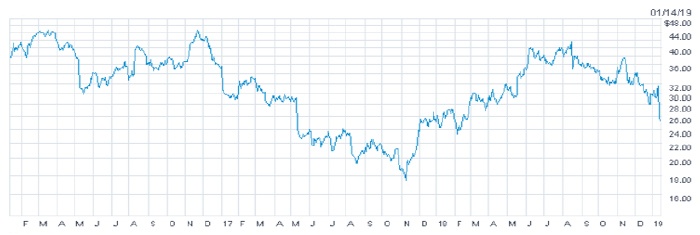
Last Thursday (Jan. 10) saw a segmentwide sharp downturn for traditional retailers’ shares, especially department stores. This was triggered by reports from Macy’s and other retailers that November and December holiday season sales fell short of expectations. Macy’s reported that combined online and in-store sales were up just 1.1%. Macy’s (M) shares fell about 18% for the day.
According to CNBC,
A statement from Macy’s CEO Jeff Gennette said, in part,
Fox Business News said, referring to Macy’s stock, “The percentage decrease was Macy’s largest decline dating back to at least February 5, 1992, according to data from Dow Jones Market Data Group. The plunge erased $1.7 billion from Macy’s overall valuation.”
The recent decline came after some end-of-year weakness for the stock and the overall market, but in the one-year period leading up to the fall of 2018, Macy’s stock had basically doubled on the market’s anticipation of positive results from recent turnaround efforts.

Source: nasdaq.com
The National Retail Federation (NRF) had predicted in mid-December that retail sales would be very healthy for the holiday period. That forecast may be at risk unless major online retailers overcome the relative weakness anticipated for many brick-and-mortar stores. According to Digital Commerce 360, 2018 online sales will grow about 17% for the holidays versus 2017, supporting an overall retail sales increase of more than 5%.
A press release from NRF on Dec. 14, 2018, said,
“‘Consumers have the capacity and confidence to spend this holiday season,’ NRF Chief Economist Jack Kleinhenz said, citing the influence of stronger employment, improved wages, tax cuts, and increased net worth. ‘This is a good start to the holiday season and consistent with our outlook. Consumer spending remains solid and clearly provides evidence that the economy is healthy as we head into 2019.’
“NRF’s forecast predicts that holiday retail sales during November and December will increase between 4.3 and 4.8 percent over the same period in 2017 for a total between $717.45 billion and $720.89 billion. As of November, the three-month moving average was up 4.3 percent over the same period a year ago. The November results build on improvement seen in October, which was up the same 0.7 percent monthly and 5.6 percent year-over-year.”
Unfortunately, as of this writing (Jan. 15), the government shutdown may delay the release of important economic data that would shed light on retail sales for December (due out on Jan. 16) and other important economic data.
The Washington Post wrote on Jan. 14:
